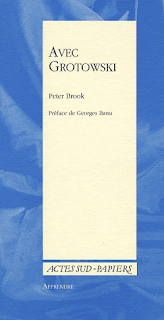When you are unique you can be amazing, that’s what Ziya Azizi’s performance is: amazing, spectacular, beautiful, and dramatic.
Yesterday (1) I saw Ziya Azazi performing Dervish in Progress, one of his latest works (2004). The last 11 years he has been whirling not as a mystic dancer but as an artistic one. What does that mean? That Ziya is not a dervish or a sufi practitioner, he is a dancer, a choreographer, an artist who has found his technical way in dance through whirling. That’s why he is unique.
Watching a dervish dancing can be a dizzy experience, yes, but also a mystical one, you can be transported to another state of mind just for watching it and listening to the music; and you can also say that it is beautiful (very beautiful for many), but it stops there: there is no "a work of art", there is no ideas or interpretation to transmit to anybody beyond the practitioner's himself. “Dervish in progress” offers us, spectators, a rare opportunity to be transported to a different state (through watching whirling continuously, during 20 minutes,) mixed with a modern aesthetic experience. At Ziya Azazi’s performance we were, in one moment and in our seat, moving with him, feeling that obligatory dizziness and being amazed by his movements, but also he was telling us something, a kind of story, revealing to us his experience while dancing and exposing the inner conflict a dervish in progress has.
“Dervish in progress” talks about the struggle for cleansing the performer’s body and mind; it show us how, during the movement, the dancer is transported to another state but also how his experience as a dancer become more powerful than the religious motives that set him originally in motion. Whirling gives him a freedom that ideas and mental postures cannot. We are then witnesses to his fight and to his cleansing, watching how, without stoping whirling (which is remarkable), he takes off his hat, his shirt and two skirts to end up wearing only one black skirt; we also see how, in the same way he took off his clothes, he gets rid of his religious beliefs, throwing away the gestures of the three main religious traditions: the Christian sign of the cross with his hand, the muslim salutation with the palm on the heart, onto the forehead and to the sky, and the Buddhist posture with palms together and an inclined head. That fight is not totally successful, the skirt itself finishes by absorbing him, and he practically disappears in front of our eyes: you can say he won the fight and he fused with the universe, but you can also interpret that his fight it is a tragedy, an unbearable weight that finishes by absorbing (or crushing) him.
Ziya Azazi expose his struggle, yes, his doubts and he’s not afraid to express how he is getting rid of his religious ideas (whether christian, muslim or buddhist), he is an honest artist and he has built an honest work.
I believe Ziya Azazi does with dervish whirling what Zeami did with Noh Theatre centuries ago, moving a religious art to an artistic form, “cleaning” it of any religiosity by looking at its sources, the experience of movement itself, but also by adding to it an artistic interpretation and the dramatic possibilities to transmit feelings, ideas and stories.
 |
| Program information at CanAsian's performance (Harbourfront Centre, Feb 23rd, 2011) |
This is the whole performance recorded in 2005:
DERVISH IN PROGRESS, 2005, by Ziya Azazi from
ZIYA AZAZI on
Vimeo.
This solo is a contemporary interpretation of traditional Sufi dances, reflecting Ziya Azazi’s personal, artistic, conceptual and motional analysis. Physical awareness and a high state of meditation are aimed to be represented simultaneously. It searches for the Dervish a high level of speed, tension and emotion while it suggests to create a space for the viewer to experience these moods.
This performance represents the moment of Dervish when s/he starts to enjoy his/her achievement through the joyful and ecstatic repetition of whirling: the looping of spinning which lead to trance. The three skirt costumes intensify this joy with their illuminated and diverse colours and forms.
This dynamic, metamorphic solo transforms the classical Sufi dance into a spectacular form as it suggest possibilities for joy to become ritual, without needing boundaries of existing belief systems.
Dance/Choreography: ZIYA AZAZI
Costume: ISCHIKO
Light Desing: GERMANO MILITE
Music mix based on : MERCAN DEDE
(1) That was on February 23rd, 2011 at Harbourfront Centre, Toronto.
























